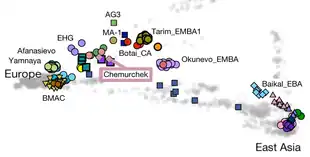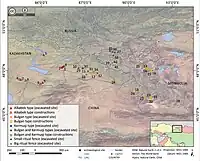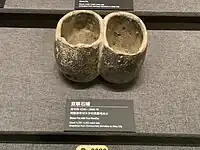46°07′41″N 91°41′14″E / 46.128186°N 91.687306°E
.png.webp) -2000 ◁ ▷ Chemurchek culture and contemporary cultures and polities circa 2000 BCE.[1] | |
| Geographical range | South Siberia |
|---|---|
| Dates | 2750-1900 BCE.[2] |
| Preceded by | Afanasievo culture |
| Followed by | Subeshi culture |

The Chemurchek culture (Ch:切木尔切克; Ru: Чемурчекская культура), also called Hemtseg, Qiemu’erqieke, Shamirshak (2750-1900 BCE), is a Bronze Age archaeological culture of western Mongolia and the borders of neighbouring countries, such as the Dzungarian Basin of Xinjiang and eastern Kazakhstan.[2] The Chemurchek burials are characterized by large rectangular stone fences, built around collective tombs. The mortuary position of the deceased (supine position with flexed legs) is similar to that of the Afanasievo culture. Anthropomorphic standing stones were erected next to the tombs, on their eastern side.[2]
In the tombs, artifacts have been recovered, such as stone bowls, bone tools, ceramics (grey wares with sophisticated patterns of incised decoration), or metal jewelry.[2] Bronze artifacts too are available.[4]
Dental analysis has shown that the Chemurchek culture consumed ruminant dairy products.[2]
The people of the Chemurchek culture were apparently descendants of Afanasievo populations intermixed with local populations.[1] In the Altai Mountains and to the southeast, Afanasievans seem to have coexisted with the early period of the Chemurchek culture for some time, as some of their burials are contemporary and some of the artifacts of the burials coincide.[5] The Chemurchek culture had various characteristics of West European origin.[6]
Another Chemurcheck burial site was discovered in Yagshiin khuduu in Bulgan soum, Khovd aimag, which contained the oldest kurgan stelae discovered so far in Mongolia.[7]
 Chemurchek funerary and ritual structures
Chemurchek funerary and ritual structures Chemurchek burial mound in western Mongolia, along with accompanying standing stone.[8]
Chemurchek burial mound in western Mongolia, along with accompanying standing stone.[8] Chemurchek burials, carbon dates
Chemurchek burials, carbon dates_Burial%252C_circa_2500_BCE.jpg.webp) Chemurchek sanctuary Hulagash (Bayan-Ulgii aimag, Mongolia) Burial, circa 2500 BCE
Chemurchek sanctuary Hulagash (Bayan-Ulgii aimag, Mongolia) Burial, circa 2500 BCE_Burial%252C_forensic_reconstruction_of_the_skull%252C_circa_2500_BCE.jpg.webp) Chemurchek sanctuary Hulagash (Bayan-Ulgii aimag, Mongolia) Burial, forensic reconstruction of the skull, circa 2500 BCE
Chemurchek sanctuary Hulagash (Bayan-Ulgii aimag, Mongolia) Burial, forensic reconstruction of the skull, circa 2500 BCE Stone pot with two mouths, 4200-3900 BCE, Chemurcheck cemetery, Altay City.
Stone pot with two mouths, 4200-3900 BCE, Chemurcheck cemetery, Altay City..jpg.webp) Stone ware, Yagshiin khuduu in Bulgan soum, Khovd aimag. National Museum of Mongolia
Stone ware, Yagshiin khuduu in Bulgan soum, Khovd aimag. National Museum of Mongolia.jpg.webp) Bronze earring, Yagshiin khuduu in Bulgan soum, Khovd aimag. National Museum of Mongolia
Bronze earring, Yagshiin khuduu in Bulgan soum, Khovd aimag. National Museum of Mongolia
References
- 1 2 Zhang et al. 2021.
- 1 2 3 4 5 Jeong et al. 2020.
- ↑ Zhang, Fan; Ning, Chao; Scott, Ashley (November 2021). "The genomic origins of the Bronze Age Tarim Basin mummies". Nature. 599 (7884): 256–261. Bibcode:2021Natur.599..256Z. doi:10.1038/s41586-021-04052-7. ISSN 1476-4687. PMC 8580821. PMID 34707286.
- ↑ Betts, Jia & Abuduresule 2019.
- ↑ Kovalev, A. A., and Erdenebaatar, D. (2009). Discovery of new cultures of the Bronze Age in Mongolia according to the data obtained by the international Central Asian archaeological expedition. In Bemmann, J., Parzinger, H., Pohl, E., and Tseveendorzh, D. (eds.), Current Archaeological Research in Mongolia, Rheinische Friedrich-Wilhelms-Universität, Bonn, p.158: "Two 14C-dates that have come from the charcoal found in the earliest (ritual) pit of Chemurchek barrow No. 2 appeared to be in the same period as the four radiocarbon dates from the charcoal in the fi lling of the burial pit of barrow No. 1 that belongs to the Afanasievo culture. It may indicate that during the earliest period of existence of the Chemurchek culture, its population in the Altai region maybe coexisted with population of the Afanasievo culture. A pillar, erected at the eastern side of an Afanasievo culture barrow (Fig. 1.1), as well as the finding of a bone arrowhead (Fig. 1.4), which is similar to arrowheads from Kulala Ula 1 and Kara Tumsik barrows (Fig. 2.10,12), also confirm this proposition."
- ↑ Kovalev, A.A.; Solodovnikov, K.N.; Munkhbayar, Ch.; Erdene, M.; Nechvaloda, A.I.; Zubova, A.V. (2 March 2020). "Paleoanthropological study of a skull from a burial at the Chemurchek sanctuary Hulagash (Bayan-Ulgii aimag, Mongolia)". Vestnik Arheologii, Antropologii I Etnografii. 1 (48): 78–95. doi:10.20874/2071-0437-2020-48-1-8. S2CID 213820119.
the so-called Chemurchek cultural phenomenon — a set of characteristics of West European origin, which appeared there no later than 2700–2600 BC
- ↑ "Collection of the National Museum of Mongolia: The Oldest Kurgan Stelae discovered in Mongolia". MONTSAME News Agency.
- ↑ Kovalev, Alexey (2022). Megalithic traditions in the Early Bronze Age of the Mongolian Altai: the Chemurchek (Qie'muerqieke) cultural phenomenon. Oxford: Archaeopress.
Sources
- Betts, A.; Jia, P.; Abuduresule, I. (1 March 2019). "A new hypothesis for early Bronze Age cultural diversity in Xinjiang, China". Archaeological Research in Asia. 17: 204–213. doi:10.1016/j.ara.2018.04.001. ISSN 2352-2267.
- Jeong, Choongwon; Wang, Ke; Wilkin, Shevan; Taylor, William Timothy Treal; Miller, Bryan K.; Bemmann, Jan H.; Stahl, Raphaela; Chiovelli, Chelsea; Knolle, Florian; Ulziibayar, Sodnom; Khatanbaatar, Dorjpurev; Erdenebaatar, Diimaajav; Erdenebat, Ulambayar; Ochir, Ayudai; Ankhsanaa, Ganbold; Vanchigdash, Chuluunkhuu; Ochir, Battuga; Munkhbayar, Chuluunbat; Tumen, Dashzeveg; Kovalev, Alexey; Kradin, Nikolay; Bazarov, Bilikto A.; Miyagashev, Denis A.; Konovalov, Prokopiy B.; Zhambaltarova, Elena; Miller, Alicia Ventresca; Haak, Wolfgang; Schiffels, Stephan; Krause, Johannes; Boivin, Nicole; Erdene, Myagmar; Hendy, Jessica; Warinner, Christina (12 November 2020). "A Dynamic 6,000-Year Genetic History of Eurasia's Eastern Steppe". Cell. 183 (4): 890–904. doi:10.1016/j.cell.2020.10.015. ISSN 0092-8674. PMC 7664836. PMID 33157037. S2CID 214725595.
- Zhang, Fan; Ning, Chao; Scott, Ashley; Fu, Qiaomei; Bjørn, Rasmus; Li, Wenying; Wei, Dong; Wang, Wenjun; Fan, Linyuan; Abuduresule, Idilisi; Hu, Xingjun; Ruan, Qiurong; Niyazi, Alipujiang; Dong, Guanghui; Cao, Peng; Liu, Feng; Dai, Qingyan; Feng, Xiaotian; Yang, Ruowei; Tang, Zihua; Ma, Pengcheng; Li, Chunxiang; Gao, Shizhu; Xu, Yang; Wu, Sihao; Wen, Shaoqing; Zhu, Hong; Zhou, Hui; Robbeets, Martine; Kumar, Vikas; Krause, Johannes; Warinner, Christina; Jeong, Choongwon; Cui, Yinqiu (November 2021). "The genomic origins of the Bronze Age Tarim Basin mummies". Nature. 599 (7884): 256–261. Bibcode:2021Natur.599..256Z. doi:10.1038/s41586-021-04052-7. ISSN 1476-4687. PMC 8580821. PMID 34707286. S2CID 240072904.